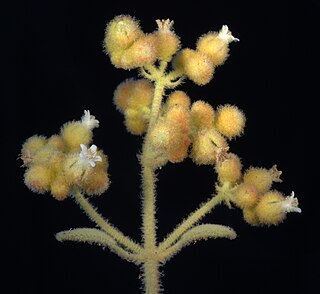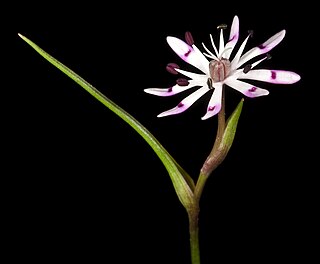
Baeckea is a genus of flowering plants in the myrtle family, Myrtaceae. There are about 75 species, of which 70 are endemic to Australia; the others are distributed in New Caledonia and Southeast Asia.

Mirbelia is a plant genus belonging to the family Fabaceae. It is endemic to Australia, occurring in every mainland state except South Australia.

Maireana is a genus of around 57 species of perennial shrubs and herbs in the family Amaranthaceae which are endemic to Australia. Species in this genus were formerly classified within the genus Kochia. The genus was described in 1840 by the botanist, Moquin-Tandon and named to honour Joseph François Maire (1780-1867), an amateur botanist who befriended him during the author's first visit to Paris in 1834.

Atriplex cinerea, commonly known as grey saltbush, coast saltbush, barilla or truganini, is a plant species in the family Amaranthaceae. It occurs in sheltered coastal areas and around salt lakes in the Australian states of Western Australia, South Australia, Tasmania, Victoria and New South Wales.

Muehlenbeckia adpressa, commonly known as climbing lignum, is a prostrate or climbing plant, native to Australia. It has thin red-brown stems up to 1 metre in length. The leaves are 1.5–6 centimetres (0.59–2.36 in) long and 1.5–3.5 centimetres (0.59–1.38 in) wide. It occurs in coastal areas of Western Australia, South Australia, Tasmania, Victoria and New South Wales.
Cissus adnata is a woody vine species in the genus Cissus found in Asia and Australia.

Seringia integrifolia is a shrub of the family Malvaceae native to inland Australia in New South Wales, South Australia, Western Australia, Queensland, and the Northern Territory.

Amyema fitzgeraldii, the pincushion mistletoe, is a species of flowering plant within the genus Amyema, an epiphytic hemiparasitic plant of the family Loranthaceae endemic to Australia, and found in the Northern Territory, South Australia and Western Australia.

Amyema gibberula is an aerial hemiparasitic plant of the family Loranthaceae native to Australia and found in Western Australia, the Northern Territory, and South Australia.

Dicrastylis exsuccosa is a species of plant within the genus, Dicrastylis, in the family Lamiaceae. It is endemic to inland Australia and found in Western Australia, the Northern Territory and South Australia.

Opercularia echinocephala is a species of plant within the genus, Opercularia, in the family Rubiaceae. It is endemic to the southwest of Western Australia.

Maireana pyramidata is a species of plant within the genus, Maireana, in the family Chenopodiaceae. It is endemic to Australia, and widespread throughout Australia in the inland, where it is found in Victoria, New South Wales, Queensland, the Northern Territory and Western Australia.

Amyema melaleucae, also known as the tea-tree mistletoe, is a species of flowering plant within the genus Amyema, an epiphytic hemiparasitic plant of the family Loranthaceae native to Australia and found in Western Australia and South Australia on the coast, from north of Perth almost to the Victorian border.

Trachymene ornata, or spongefruit, is a slender annual herb in the family Araliaceae. It is native to Australia and found in Western Australia, South Australia and New South Wales.

Daviesia hakeoides, is a spiny shrub species in the family Fabaceae. It is endemic to Western Australia. It grows to from 0.2 to 1 metre high and has yellow/orang/red/brown pea flowers, produced between May and September in the species' native range. It grows in gravelly soils, sand and granite on stony hills, sandplains and flats.

Cheyniana microphylla is a plant in the family Myrtaceae which is endemic to Western Australia.

Rumex vesicarius, also known as Ruby dock, or bladder dock, is a species of perennial flowering plant in the family Polygonaceae. According to Plants of the World Online, Rumex vesicarius is native to tropical and temperate Asia, Africa, and Western Australia. However, the Council of Heads of Australasian Herbaria asserts that within Australia it is naturalised in Western Australia, the Northern Territory, South Australia, Queensland and New South Wales.

Wurmbea tenella, common name - eight nancy, is a perennial herb in the Colchicaceae family that is native to Western Australia.

Roycea pycnophylloides, commonly known as Saltmat, is a species of shrub endemic to Western Australia. It has no synonyms.


















